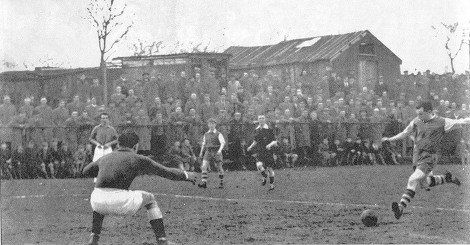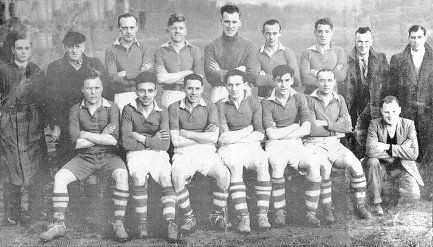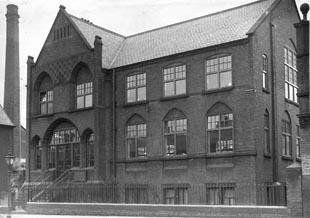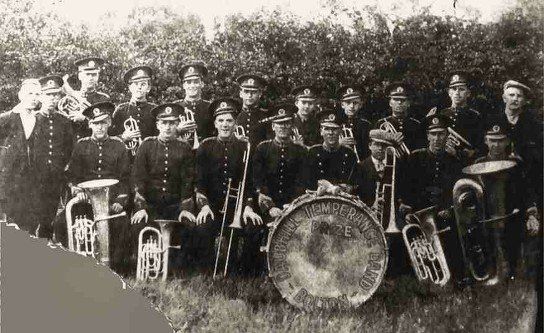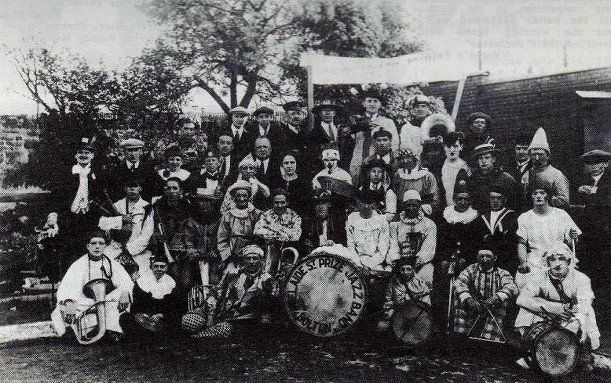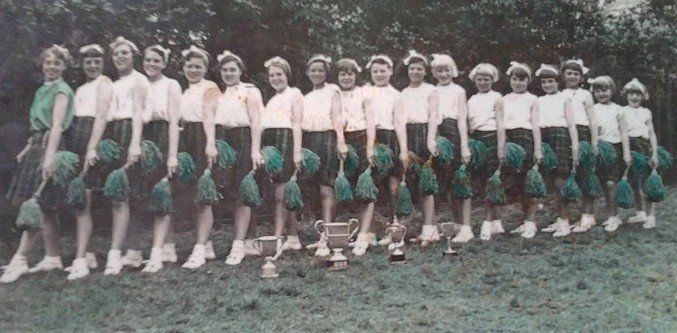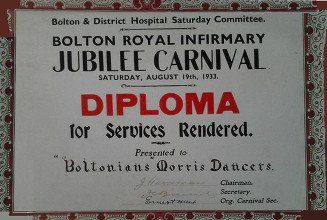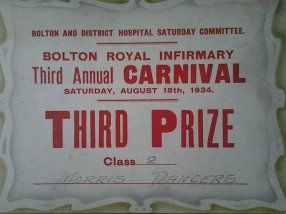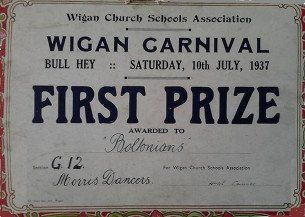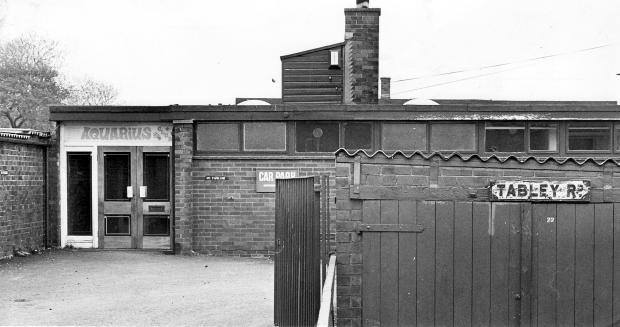The turn of the century was a time when the working person had leisure and the money to enjoy it that had never been known before. It was a time when people went on trips by charabanc(!) and by the newly available passenger trains and cycling clubs were established. It was also a time of increasing political awareness. People were educated to a far greater degree even than their own parents had been. The Labour movement and the rise of the Trade Unions made the working men aware of the power of politics and intellectual discussions about socialism (and by some how to combat it) were relatively common. The Conservative Clubs and Labour Clubs (and especially Bolton Socialist Party at Wood Street in Bolton town centre) were places of discussion and activism and not just the entertainment and drinking clubs into which they later degenerated. (It must be said that in recent years the Wood Street Socialist Club has again hosted topical, socialist lectures and discussions.)
The Rumworth and Hulton Conservative Club on the corner of St Helens Road and Nixon Road commenced building (according to the foundation stones) in 1894. The Rumworth Labour club at the corner of Prescott Street and St Helens Road was active from some time before 1920 (originally at the top of Adelaide Street). Both are still going strong at the present time (original text 2012, still true 2021).
At some point around the turn of the twentieth century, Rumworth Skating Rink was opened at a position in front of the present Majesty Van Hire site. Skating was however soon overtaken by another leisure activity.
Bolton Evening News 21 August 1911:
Rumworth Electric Theatre, Daubhill, St Helens Road, Bolton. Grand opening week commencing tonight, Monday August 21 at 6pm, with the finest display of pictures ever shown in Bolton. No jumping! No flickering! Every picture clear and distinct. All seats are guaranteed. Continuous shows from 6 to 10.30. Seats cosy and comfortable. No wooden forms, all padded seats. Children’s matinee every Saturday afternoon at 2.30, half price. People’s popular prices 2d., 4d., 6d.
The cinema was later renamed The Majestic and provided entertainment until the late 1950s. Before WWII it was possible to go in to the cinema for half price and stand behind the screen. Some people who did this regularly, took mirrors through which to view the pictures. On the back rows were a number of double “courting seats”. For many years the children’s Saturday matinee cost 3d. There was always lots of stamping at exciting times and it was not unusual for the manager to stop the film and come out to the front of the cinema demanding that the kids keep the noise down or the film would be stopped and not started again. The children’s programme always ended with a serial, a “cliff-hanger”. At one period it was possible to get into the cinema without money by paying with empty jam-jars.
There are stories of less official attempts to get in free. One gentleman recalls in his younger days going in through the front door and when the attendant was not watching, into the toilets. Ten minutes later, bold as brass, he would leave the toilets and walk straight into the cinema as if he had previously left the auditorium to go to the gents.
Evening showings were “continuous”. If you planned to go to the second showing of a film (often called “the second house” but that was not quite sensible for continuous performances) it usually happened that you went into the cinema 10 or 15 minutes before the first showing of the “big film” had finished. (How annoying for the first house people waiting for the denouement!) You then sat through the B film, the newsreel, the adverts, perhaps a cartoon and then watched the main film. Towards the end you would hear, from various parts of the auditorium, “This is where we came in,” and people would get up at that point and leave. (Again very annoying for the other people who would have preferred to watch the film to the end undisturbed.) There was often quite a stampede for the doors at the end of the film as the credits began to roll. Of course few people really wanted to read the credits but the main reason was to get out before having to stand for the National Anthem!
Falling cinema attendances and perhaps the need for expensive maintenance meant the Majestic eventually closed its doors for the last time. In any case the brave new modern post-war world had other things to do. Around 1960 the Majestic was demolished and so too was a row of little cottages, set well back from the road, with long gardens and stone flag garden walls, on the other side of the road. In their place two symmetrically placed petrol stations were built. The planners clearly thought that the growth of motor car use would be so great that two petrol stations would easily have enough business, and two facing one another meant that you could always enter a garage without having to cross the road. Of course there was never enough passing traffic for two garages and the locals rapidly decided which was their favourite garage and never went to the other one.
This is the only picture I have ever seen of the Majestic Cinema. It also shows the whole Sunnyside Mills complex,the 1828 and the 1885 routes of the railwayand the termination of the old line at Adelaide Street, the Sunnyside Hotel, the Ellesmere Road Bridge and the bridge lower down which went from a no-man's-land in the part of Woodbine Road that never materialised to the no-man's-land at the south-west corner of Sunnyside Mill; we can also see (top) a corner of the Swan Lane Spinning Company Mill, Rumworth Mill between Sunnyside and St Helens Road and are just short (at the very bottom) of seeing the level crossing. If your eyes are good you will see the Daubhill clock.
The date of the picture is no later than 1931 because the Holiness Tabernacle has not yet appeared.
Rumworth Mill still stands - other things marked as "still standing" are not by 2021.
Picture first posted on Facebook by "Relief Signalman"
The Esso garage on the site of the Majestic became much the more popular and the Texaco garage on the site of the cottages closed after a few years to become a taxi office, a car wash and a body-work workshop. The Majestic garage was originally owned by Bill Harrison who later sold it to Graham Sinnot (query - who had been a mechanic there). The Majestic garage remained open for much longer than Texaco but closed eventually though the final owner continued his business as Majestic Van Hire behind the garage site. Steve Winward (Daubhill facebook group) remembers the cashier at the Esso garage who "had the biggest beehive (hair style) in the world and I think she was the first person in the world to wear false eyelashes, they were HUGE – and false nails!.
Picture (C) Gene Watts but with a lot of work by me.
She was really nice and used to give me FA cup winner coins for my collection, they were supposed to be given with a set amount of petrol, however she used to give me one on a regular basis."
The Majestic site remained empty for many years but has become (from about 2008) a car wash and a depot for lorries transporting road-stone.
Sometime prior to 1930 (possibly pre-WWI but probably after 1910) a Billiard Hall opened on the spare ground between Hooton Street and the railway. This was built of wood which had been tarred and gave the appearance of a solid lump of black, rather forbidding to children who were in any case forbidden both by their parents and by the owner to go in it. Always "Billiard Hall" to me it was later known as the "Snooker Hall" and later still sometimes the "Pool Hall" or "Pill Hall". It was open to men only but one lady emailed me to say how, suitably attired, she was sometimes sneaked in by the lads. Many people remember the proprietor Harry Wright. I am told he bought it from Tommy White who later ran a taxi firm. (Query, was it the other way round, Tommy White was later?) Barry Stanton remembers the Snooker Hall, still run by Harry and Mrs Wright, in the 1980s and perhaps into the 1990s. Sometime in the 1990s it became an Asian Community Centre but in August 2000 it was damaged by fire, thought to be an arson attack. Andrea Casey recalls:- I used to live in Hooton St. I remember waking up and thinking the light was on but it was the fire. I lived at no14 so was at the other end of the street. I ended up making tea for 13 firemen.
Report from Bolton News Archives:- 20th August 2000
Arsonists attack community centre
ARSONISTS have caused thousands of pounds worth of damage to an Asian community centre. The blaze swept through the wooden building at the Ramakrishna Vivekananda Mission UK Centre, on Hooton Street, Daubhill, destroying two rooms and leaving the main hall heavily smokelogged.
Books in a storeroom were set on fire after the building was broken into in the early hours of Sunday morning. Roy Choudhuri, president of the centre, said he felt "shell-shocked" when he was woken by a phone call from firefighters to be told of the news in the early hours of Sunday morning. He said: "The centre is unusable and it will be some time before we'll be able to see the full extent of the damage."
Firefighters were called out at 12.30am to tackle the blaze and remained there dampening down until 2.55am. Three fire engines from Bolton North and Farnworth fire stations were sent to tackle the blaze. They battled with the fierce flames to prevent them spreading to the main hall.
Police are investigating the fire which happened a month before the centre's users were due to move to new premises in the town.
A resident in Hooton Street, who did not want to be named, said: "It was frightening in case the whole lot went up. The heat would have damaged the houses round about. It's a terrible thing to have happened."
Howard Crompton who lived in Hooton Street but now lives abroad says: The Billiard Hall was run by Harry Wright ( a bald headed man who was locally nicknamed “Bullet “ due to his shiny dome). He ran it with his wife always respectfully known as “Mrs Wright” and I went to school with his son Steven Wright so I used to play with him and went into the hallowed place before the legal age that Harry allowed . The billiard hall had a coal fired boiler outside in a little lean-to. The Wrights then lived on Lever Edge Lane. It was always a magnet for burglars who tried to get in to steal the ciggies that Harry sold and stored in there . No alcohol just tea and warm Vimto and pop were the standard refreshments and crisps (and ciggies, usually Woodbines, Park Drive and Players). Two or three old pinball machines and wall games (spinning a ball bearing around into numbered holes) you always hoped to win money on them.
It was a great facility and I remember becoming a member and learning my basic snooker skills there. As a youngster you would be allowed on the bottom tables ( no spring on the cushions and baize a little on the thin side (you certainly knew your place) and then eventually as Harry or his Mrs got to assess your skills ( or good patronage) you would get rewarded and put on the better tables. The ultimate was the hallowed top table (for club games tables and for the best players............like playing at the snooker equivalent of Wembley for a young lad ! ), the one next to the office cum refreshment kiosk that was the Wrights' domain .
I played in there well into my late teens with my mates (yes the well clichéd misspent youth). Kicked out the Stags Head in the afternoon after 3.00 pm last orders, it was head to Harry’s for a game of “Mystery “ with the lads or a game of after pub footie on Hulton Lane playing fields.
During WWII air-raid shelters were built between the billiard hall and the railway wall, brick walls, flat concrete roof, no windows of course but small ventilation holes, just missing bricks really. These would have been demolished probably in the mid 1950s.
Howard Crompton again: I remember the old air raid shelter; you could not get into it but I remember climbing on top of it before Jean Whittle living at the top of Hooton Street would come out and threaten to tell my Mum & Dad if we didn’t get down; it was a no go zone and she fiercely protected her patch from intruders, especially noisy kids, and used old retort “ go and play in front or your own house “ on a regular basis due to her famous migraines.
There were two local football Clubs. These are probably post-war. Daubhill Athletic’s pitch was immediately south of Rumworth (Willows) Park and occupied part of the land previously taken up by the “Shale Hole”, the clay pit adjoining Higson’s brickworks. It is not clear on the 1953 map but appears on maps between 1956 and 1967. Lomax’s FC ground was on Pelham Street, beyond and behind Woodbine Road and is marked on the 1967 map though by this time this space was occupied by Evan’s waste paper depot. NAT LOFTHOUSE played for Lomax's before turning professional. Lofthouse went to Brandwood Street School, see Education page and http://www.englandfootballonline.com/TeamPlyrsBios/PlayersL/BioLofthouseN.html
Daubhill Athletic FC 1950, posted on Facebook by Edward Thompson
It seems that Daubhill even had its own brass band. A picture was posted on Facebook but very little information is known. Daubhill Temperance Prize Band was possibly formed in 1924 by the Evans Bros but disbanded at the start of WWII. Three of its members died in a POW camp. Pauline Kay (nee Holt) says, "My Grandfather played with them before WW II.
Nancy Queally says - My Dad (Stanley Evans) is on this photo of the band, front row euphonium. She wonders if its originator might be a long lost relative and would like to get in touch with them.
Brass Bands were traditional but Dobble was more modern in its musical outlook. Here we have the Adelaide Street Prize Jazz Band pictured in 1926. This picture is from a collection of unusual Lancashire bands posted by D Middlehurst on flickr. https://www.flickr.com/photos/15974550@N03/sets/72157630715027350/with/9660412477/
I have no information about this band but it seems that they are featured on a film (silent, alas) preserved by the North West Film Archive at Manchester Metropolitan University.
http://www.nwfa.mmu.ac.uk/viewVideo.php?token=0517agw5646b49114404m6611b
Film Number: 1156 Title: REDDISH CRIPPLED CHILDREN'S MAY QUEEN FESTIVAL MAY 13th 1933
Producer: Preston Brothers - Date: 1933 - Colour: b/w - Sound: silent - Running Time: 17 mins 52 secs
Description: May Queen festival celebrations in Reddish on May 13th 1933. The procession starts from Gorton Road and includes shots of the Adelaide Street Prize Jazz Band from Bolton and the Newton Social Jazz Band from Hyde. The May Queen (Miss Doris Tidswell) and her retinue parade through the streets with various fancy dress competitors and a selection of carnival floats.
[The preservation of this film was funded by a grant from the National Heritage Memorial Fund.]
Patricia Jones has sent me a picture of The Boltonians Morris Dancers, all from the Daubhill area, as they proudly display their trophies. They did not have any fixed location and often practised in the fields around Daubhill. It is thought they may have danced with one of or both the above bands. Pat's Mum (Miss Conroy) is the leader at the front of the line.
On the next page we look at Education from around 1858



